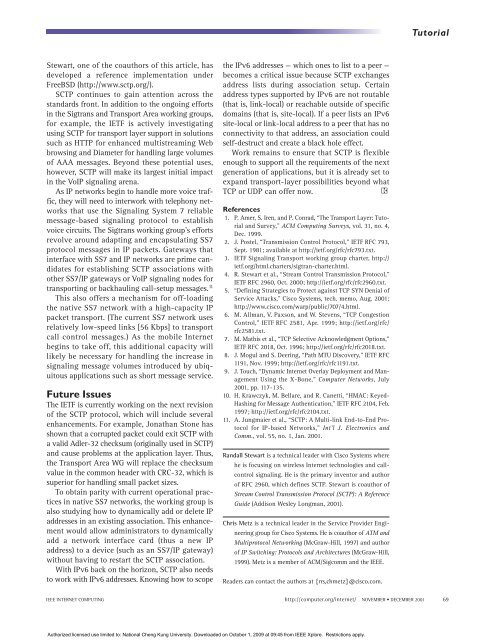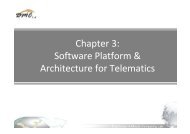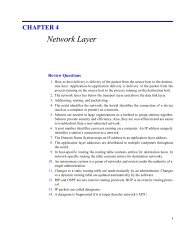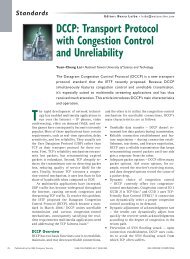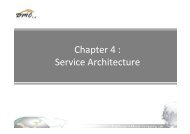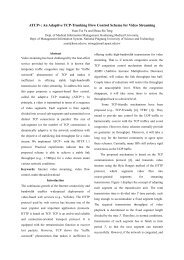SCTP: new transport protocol for TCP/IP - Internet Computing, IEEE
SCTP: new transport protocol for TCP/IP - Internet Computing, IEEE
SCTP: new transport protocol for TCP/IP - Internet Computing, IEEE
Create successful ePaper yourself
Turn your PDF publications into a flip-book with our unique Google optimized e-Paper software.
TutorialStewart, one of the coauthors of this article, hasdeveloped a reference implementation underFreeBSD (http://www.sctp.org/).<strong>SCTP</strong> continues to gain attention across thestandards front. In addition to the ongoing ef<strong>for</strong>tsin the Sigtrans and Transport Area working groups,<strong>for</strong> example, the IETF is actively investigatingusing <strong>SCTP</strong> <strong>for</strong> <strong>transport</strong> layer support in solutionssuch as HTTP <strong>for</strong> enhanced multistreaming Webbrowsing and Diameter <strong>for</strong> handling large volumesof AAA messages. Beyond these potential uses,however, <strong>SCTP</strong> will make its largest initial impactin the Vo<strong>IP</strong> signaling arena.As <strong>IP</strong> networks begin to handle more voice traffic,they will need to interwork with telephony networksthat use the Signaling System 7 reliablemessage-based signaling <strong>protocol</strong> to establishvoice circuits. The Sigtrans working group’s ef<strong>for</strong>tsrevolve around adapting and encapsulating SS7<strong>protocol</strong> messages in <strong>IP</strong> packets. Gateways thatinterface with SS7 and <strong>IP</strong> networks are prime candidates<strong>for</strong> establishing <strong>SCTP</strong> associations withother SS7/<strong>IP</strong> gateways or Vo<strong>IP</strong> signaling nodes <strong>for</strong><strong>transport</strong>ing or backhauling call-setup messages. 11This also offers a mechanism <strong>for</strong> off-loadingthe native SS7 network with a high-capacity <strong>IP</strong>packet <strong>transport</strong>. (The current SS7 network usesrelatively low-speed links [56 Kbps] to <strong>transport</strong>call control messages.) As the mobile <strong>Internet</strong>begins to take off, this additional capacity willlikely be necessary <strong>for</strong> handling the increase insignaling message volumes introduced by ubiquitousapplications such as short message service.Future IssuesThe IETF is currently working on the next revisionof the <strong>SCTP</strong> <strong>protocol</strong>, which will include severalenhancements. For example, Jonathan Stone hasshown that a corrupted packet could exit <strong>SCTP</strong> witha valid Adler-32 checksum (originally used in <strong>SCTP</strong>)and cause problems at the application layer. Thus,the Transport Area WG will replace the checksumvalue in the common header with CRC-32, which issuperior <strong>for</strong> handling small packet sizes.To obtain parity with current operational practicesin native SS7 networks, the working group isalso studying how to dynamically add or delete <strong>IP</strong>addresses in an existing association. This enhancementwould allow administrators to dynamicallyadd a network interface card (thus a <strong>new</strong> <strong>IP</strong>address) to a device (such as an SS7/<strong>IP</strong> gateway)without having to restart the <strong>SCTP</strong> association.With <strong>IP</strong>v6 back on the horizon, <strong>SCTP</strong> also needsto work with <strong>IP</strong>v6 addresses. Knowing how to scopethe <strong>IP</strong>v6 addresses — which ones to list to a peer —becomes a critical issue because <strong>SCTP</strong> exchangesaddress lists during association setup. Certainaddress types supported by <strong>IP</strong>v6 are not routable(that is, link-local) or reachable outside of specificdomains (that is, site-local). If a peer lists an <strong>IP</strong>v6site-local or link-local address to a peer that has noconnectivity to that address, an association couldself-destruct and create a black hole effect.Work remains to ensure that <strong>SCTP</strong> is flexibleenough to support all the requirements of the nextgeneration of applications, but it is already set toexpand <strong>transport</strong>-layer possibilities beyond what<strong>TCP</strong> or UDP can offer now.References1. P. Amer, S. Iren, and P. Conrad, “The Transport Layer: Tutorialand Survey,” ACM <strong>Computing</strong> Surveys, vol. 31, no. 4,Dec. 1999.2. J. Postel, “Transmission Control Protocol,” IETF RFC 793,Sept. 1981; available at http://ietf.org/rfc/rfc793.txt.3. IETF Signaling Transport working group charter, http://ietf.org/html.charters/sigtran-charter.html.4. R. Stewart et al., “Stream Control Transmission Protocol,”IETF RFC 2960, Oct. 2000; http://ietf.org/rfc/rfc2960.txt.5. “Defining Strategies to Protect against <strong>TCP</strong> SYN Denial ofService Attacks,” Cisco Systems, tech. memo, Aug. 2001;http://www.cisco.com/warp/public/707/4.html.6. M. Allman, V. Paxson, and W. Stevens, “<strong>TCP</strong> CongestionControl,” IETF RFC 2581, Apr. 1999; http://ietf.org/rfc/rfc2581.txt.7. M. Mathis et al., “<strong>TCP</strong> Selective Acknowledgment Options,”IETF RFC 2018, Oct. 1996; http://ietf.org/rfc/rfc2018.txt.8. J. Mogul and S. Deering, “Path MTU Discovery,” IETF RFC1191, Nov. 1999; http://ietf.org/rfc/rfc1191.txt.9. J. Touch, “Dynamic <strong>Internet</strong> Overlay Deployment and ManagementUsing the X-Bone,” Computer Networks, July2001, pp. 117-135.10. H. Krawczyk, M. Bellare, and R. Canetti, “HMAC: Keyed-Hashing <strong>for</strong> Message Authentication,” IETF RFC 2104, Feb.1997; http://ietf.org/rfc/rfc2104.txt.11. A. Jungmaier et al., “<strong>SCTP</strong>: A Multi-link End-to-End Protocol<strong>for</strong> <strong>IP</strong>-based Networks,” Int’l J. Electronics andComm., vol. 55, no. 1, Jan. 2001.Randall Stewart is a technical leader with Cisco Systems wherehe is focusing on wireless <strong>Internet</strong> technologies and callcontrolsignaling. He is the primary inventor and authorof RFC 2960, which defines <strong>SCTP</strong>. Stewart is coauthor ofStream Control Transmission Protocol (<strong>SCTP</strong>): A ReferenceGuide (Addison Wesley Longman, 2001).Chris Metz is a technical leader in the Service Provider Engineeringgroup <strong>for</strong> Cisco Systems. He is coauthor of ATM andMulti<strong>protocol</strong> Networking (McGraw-Hill, 1997) and authorof <strong>IP</strong> Switching: Protocols and Architectures (McGraw-Hill,1999). Metz is a member of ACM/Sigcomm and the <strong>IEEE</strong>.Readers can contact the authors at {rrs,chmetz}@cisco.com.<strong>IEEE</strong> INTERNET COMPUTING http://computer.org/internet/ NOVEMBER • DECEMBER 2001 69Authorized licensed use limited to: National Cheng Kung University. Downloaded on October 1, 2009 at 09:45 from <strong>IEEE</strong> Xplore. Restrictions apply.


